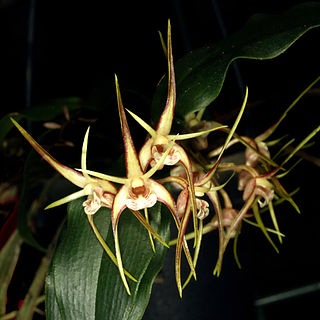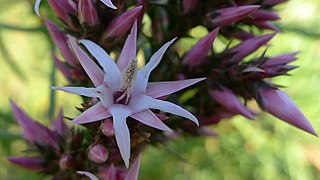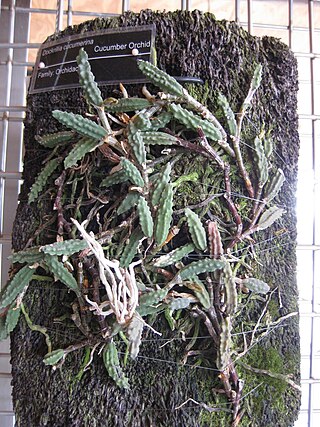
Dendrobium speciosum, commonly known as the rock orchid or cane orchid, is a species of highly variable Australian orchid. Its varieties can be found in a range of habitats as epiphytes or lithophytes. It has a continuous distribution along the east coast of Australia and in distinct populations along the Tropic of Capricorn. As a lithophyte, it forms gigantic spreading colonies on rocks and cliff faces, often exposed to full sun, with its roots forming dense, matted beds across the rock that anchor the plant. It can be found at altitudes from sea level to 900 metres (3,000 ft).

Sprengelia is a genus of flowering plants in the family Ericaceae and is endemic to eastern Australia. Plants in the genus Sprengelia are slender, erect or low-lying shrubs with overlapping, stem-clasping leaves, many bracts at the base of the flowers, the sepals egg-shaped, white or coloured, the five petals with spreading lobes, and the fruit a capsule.

Dendrobium jonesii, commonly known as the oak orchid is a species of epiphytic or lithophytic orchid endemic to far north Queensland. It has spindle-shaped pseudobulbs, up to seven thin, dark green leaves and up to thirty five crowded, star-like, fragrant cream-coloured or white flowers with purple markings on the labellum.

Dendrobium tetragonum, commonly known as the tree spider orchid, is a variable species of epiphytic or lithophytic orchid endemic to eastern Australia. Tree spider orchids are unusual in having pendulous pseudobulbs that are thin and wiry near the base then expand into a fleshy, four-sided upper section before tapering at the tip. There are only a few thin but leathery leaves at the end of the pseudobulbs and up to five flowers on relatively short flowering stems. To allow for the variations in the species there are five subspecies and a variety, some with a unique common name.

Dendrobium striolatum, commonly known as the streaked rock orchid is a species of orchid endemic to eastern Australia. It is a small, usually lithophytic orchid with wiry stems, cylindrical leaves and flowering stems with one or two yellow, cream-coloured or greenish flowers with reddish stripes. It often grows on cliff faces in New South Wales, Victoria and Tasmania.

Sprengelia incarnata, commonly referred to as pink swamp-heath, is a species of flowering plant of the family Ericaceae, and is native to south-eastern Australia and New Zealand. It is an erect, glabrous shrub with sharply-pointed, stem-clasping, egg-shaped leaves, and clusters of pink, tube-shaped flowers with spreading lobes.

Dendrobium callitrophilum, commonly known as the thin feather orchid, is an epiphytic orchid in the family Orchidaceae with narrow pseudobulbs, one or two thin, leathery leaves and up to six greenish yellow flowers with a cream-coloured or apricot-coloured labellum. It grows in or near rainforest in isolated parts of tropical North Queensland.

Dendrobium cucumerinum, commonly known as the cucumber orchid or gherkin orchid, is a species of orchid endemic to eastern Australia. It is an epiphytic orchid with creeping stems, gherkin-like leaves and flowering stems with up to eighteen cream-coloured, yellowish or greenish white flowers with purple stripes. It often grows on large trees near streams but is also found in drier forests.

Dendrobium pugioniforme, commonly known as the dagger orchid is a species of orchid endemic to eastern Australia. It is an epiphytic or lithophytic orchid with pendulous, wiry stems, fleshy, sharply pointed leaves and flowering stems with one or two greenish or yellowish flowers with a white labellum. It grows on trees and rocks, mostly in humid forest.

Dendrobium lobbii, commonly known as the straggly rush orchid, is a plant in the orchid family Orchidaceae and is native to an area extending from Indochina to northern Australia. It has thin, wiry stems with stiff leaves and mostly white or cream-coloured flowers singly or in pairs in leaf axils. Its white labellum does not open widely and sometimes remains closed.

Epipogium roseum, commonly known as the ghost orchid, leafless nodding orchid or 虎舌兰 , is a leafless terrestrial mycotrophic orchid in the family Orchidaceae. It has up to sixteen cream-coloured, yellowish or pinkish flowers with an enlarged ovary on a fleshy hollow flowering stem. This ghost orchid is widely distributed in tropical Africa, Asia, Southeast Asia, New Guinea, Australia and some Pacific Islands.

Erythrorchis cassythoides, commonly known as the black bootlace orchid, is a leafless climbing orchid in the family Orchidaceae. It has long, dark brown to blackish stems and groups of up to thirty yellowish to greenish, sweetly scented flowers and is endemic to eastern Australia.

Dendrobium schoeninum, commonly known as the common pencil orchid, is an epiphytic or sometimes a lithophytic orchid in the family Orchidaceae and has thin wiry, upright or pendent stems with fleshy, grooved, dark green leaves. Its short flowering stems have one or two, rarely up to four pale green, cream-coloured or mauve flowers with purple markings on the labellum. It grows on rainforest margins in coastal New South Wales and southern Queensland.

Dendrobium racemosum, commonly known as the erect pencil orchid, is a species of orchid endemic to tropical North Queensland. It is an epiphytic or lithophytic orchid with yellowish stems, cylindrical dark green leaves and flowering stems with between eight and fifteen cream-coloured to pale yellow flowers with a thread-like tip on the labellum. It grows on trees and rocks in exposed positions in highland areas and in the tops of rainforest trees at lower altitudes.
Dendrobium rigidum, commonly known as the smooth tongue orchid or smooth tick orchid, is a species of orchid native to tropical North Queensland and to New Guinea. It is an epiphytic or lithophytic orchid with wiry, hanging stems, fleshy, dark green leaves and flowering stems with between two and seven crowded, cream-coloured, star-shaped flowers often with pink or red on the back. It grows on trees, shrubs and rocks in a paperbark swamps and rainforest.

Dendrobium toressae, commonly known as the sparkle orchid or mica orchid, is a species of epiphytic or lithophytic orchid with highly branched stems forming dense patches. The leaves are crowded, fleshy and dark green with a glittery surface. A single cream-coloured to pale pink flower with a yellow labellum develops in a leaf axil. It is endemic to tropical North Queensland.

Dendrobium malbrownii, commonly known as the McIlwraith hermit orchid, is an epiphytic or lithophytic orchid in the family Orchidaceae and is endemic to tropical North Queensland, Australia. It has thin, wiry, crowded stems each with narrow, dark green leaves and a single shiny, cream-coloured flower with a purple labellum. It grows on trees, fallen logs and rocks in rainforest on the McIlwraith Range.
Dendrobium biconvexum, commonly known as the Mount Windsor rock orchid, is a species of lithophytic orchid that is endemic to tropical North Queensland, Australia. It has spindle-shaped pseudobulbs, between two and four thick, leathery leaves and up to seventy five white or cream-coloured flowers with purple markings on the labellum.
Dendrobium coriaceum, commonly known as the inland rock orchid, is a species of lithophytic orchid that is endemic to North Queensland. It has tapered pseudobulbs, up to three thick, leathery leaves and up to forty yellow or cream-coloured flowers with purple markings on the labellum.
Dendrobium rupicoloides, commonly known as the northern rock orchid, is a species of lithophytic orchid that is endemic to tropical North Queensland. It has tapered green to reddish pseudobulbs, up to three thick, leathery leaves and up to fifty white flowers with purple markings on the labellum.





















